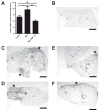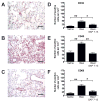Reduction of bleomycin-induced pulmonary fibrosis by serum amyloid P
- PMID: 17785842
- PMCID: PMC4482349
- DOI: 10.4049/jimmunol.179.6.4035
Reduction of bleomycin-induced pulmonary fibrosis by serum amyloid P
Abstract
Fibrotic diseases such as scleroderma, severe chronic asthma, pulmonary fibrosis, and cardiac fibrosis kill tens of thousands of people each year in the U.S. alone. Growing evidence suggests that in fibrotic lesions, a subset of blood monocytes enters the tissue and differentiates into fibroblast-like cells called fibrocytes, causing tissue dysfunction. We previously found that a plasma protein called serum amyloid P (SAP) inhibits fibrocyte differentiation in vitro. Bleomycin treatment is a standard model for pulmonary fibrosis, and causes an increase in collagen, fibrocytes, and leukocytes in the lungs, and a decrease in peripheral blood hemoglobin oxygen saturation. We find that injections of rat SAP in rats reduce all of the above bleomycin-induced changes, suggesting that the SAP injections reduced the bleomycin-induced pulmonary fibrosis. We repeated these studies in mice, and find that injections of murine SAP decrease bleomycin-induced pulmonary fibrosis. To confirm the efficacy of SAP treatment, we used a delayed treatment protocol using SAP from day 7 to 13 only, and then measured fibrosis at day 21. Delayed SAP injections also reduce the bleomycin-induced decrease in peripheral blood hemoglobin oxygen saturation, and an increase in lung collagen, leukocyte infiltration, and fibrosis. Our data suggest the possibility that SAP may be useful as a therapy for pulmonary fibrosis in humans.
Figures









Similar articles
-
The long pentraxin PTX3 promotes fibrocyte differentiation.PLoS One. 2015 Mar 16;10(3):e0119709. doi: 10.1371/journal.pone.0119709. eCollection 2015. PLoS One. 2015. PMID: 25774777 Free PMC article.
-
Persistent lung inflammation and fibrosis in serum amyloid P component (APCs-/-) knockout mice.PLoS One. 2014 Apr 2;9(4):e93730. doi: 10.1371/journal.pone.0093730. eCollection 2014. PLoS One. 2014. PMID: 24695531 Free PMC article.
-
Pirfenidone inhibits fibrocyte accumulation in the lungs in bleomycin-induced murine pulmonary fibrosis.Respir Res. 2014 Feb 8;15(1):16. doi: 10.1186/1465-9921-15-16. Respir Res. 2014. PMID: 24507087 Free PMC article.
-
The Development of Serum Amyloid P as a Possible Therapeutic.Front Immunol. 2018 Oct 16;9:2328. doi: 10.3389/fimmu.2018.02328. eCollection 2018. Front Immunol. 2018. PMID: 30459752 Free PMC article. Review.
-
Cytokines involved in pulmonary fibrosis.Int Rev Exp Pathol. 1993;34 Pt B:173-81. doi: 10.1016/b978-0-12-364935-5.50017-1. Int Rev Exp Pathol. 1993. PMID: 7681426 Review. No abstract available.
Cited by
-
New therapies for hepatic fibrosis.Clin Res Hepatol Gastroenterol. 2015 Sep;39 Suppl 1(0 1):S75-9. doi: 10.1016/j.clinre.2015.06.011. Epub 2015 Jul 20. Clin Res Hepatol Gastroenterol. 2015. PMID: 26206573 Free PMC article. Review.
-
Changes in lung sialidases in male and female mice after bleomycin aspiration.Exp Lung Res. 2022 Nov-Dec;48(9-10):291-304. doi: 10.1080/01902148.2022.2144548. Epub 2022 Nov 16. Exp Lung Res. 2022. PMID: 36382835 Free PMC article.
-
The long pentraxin PTX3 promotes fibrocyte differentiation.PLoS One. 2015 Mar 16;10(3):e0119709. doi: 10.1371/journal.pone.0119709. eCollection 2015. PLoS One. 2015. PMID: 25774777 Free PMC article.
-
Contribution of bone marrow-derived fibrocytes to liver fibrosis.Hepatobiliary Surg Nutr. 2015 Feb;4(1):34-47. doi: 10.3978/j.issn.2304-3881.2015.01.01. Hepatobiliary Surg Nutr. 2015. PMID: 25713803 Free PMC article. Review.
-
Smoking and idiopathic pulmonary fibrosis.Pulm Med. 2012;2012:808260. doi: 10.1155/2012/808260. Epub 2012 Feb 19. Pulm Med. 2012. PMID: 22448328 Free PMC article.
References
-
- Crouch E. Pathobiology of pulmonary fibrosis. Am J Physiol. 1990;259:L159–L184. - PubMed
-
- Abid SH, Malhotra V, Perry MC. Radiation-induced and chemotherapy-induced pulmonary injury. Curr Opin Oncol. 2001;13:242–248. - PubMed
-
- Davies DE, Wicks J, Powell RM, Puddicombe SM, Holgate ST. Airway remodeling in asthma: new insights. J Allergy Clin Immunol. 2003;111:215–225. - PubMed
-
- Perez A, Rogers RM, Dauber JH. The prognosis of idiopathic pulmonary fibrosis. Am J Physiol. 2003;29:S19–S26. - PubMed
-
- Thannickal VJ, Toews GB, White ES, Lynch JP, III, Martinez FJ. Mechanisms of pulmonary fibrosis. Annu Rev Med. 2004;55:395–417. - PubMed
Publication types
MeSH terms
Substances
Grants and funding
LinkOut - more resources
Full Text Sources
Other Literature Sources
Medical
Miscellaneous

